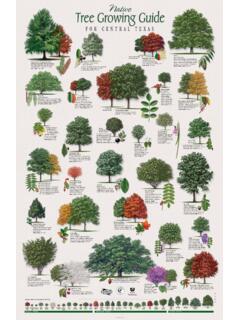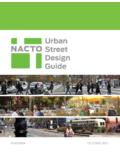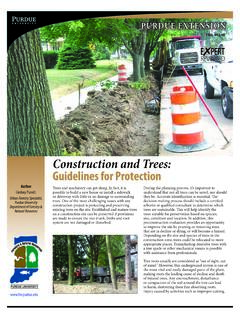Transcription of Trees and Climate Change - Utah State University
1 This factsheet describes the complex relationship between forests and Climate Change based on current research. We explain ways that Trees can mitigate some of the risks associated with Climate Change . We detail the impacts that forests are having on the changing Climate and discuss specific ways that Trees can be used to reduce or counter carbon emissions directly and indirectly. Trees and Climate Change By: Megan Dettenmaier, Michael Kuhns, Bethany Unger, Darren McAvoy What is Climate Change ? Over the last 650,000 years, the earth has experienced seven cycles of glacial advance and retreat. The earth s Climate fluctuates naturally, however, we are in a very real and significant warming trend that is human caused and temperatures are increasing faster than previously observed warming cycles. Greenhouse gases Scientific consensus indicates that significant increases in greenhouse gas emissions by humans are causing Climate Change .
2 Greenhouse gases include nitrous oxide, water vapor, methane, and carbon dioxide. They become trapped in the earth s atmosphere and retain heat, which sometimes is called the greenhouse effect . Although greenhouse gases can be produced naturally, human activity cause emissions of Photo Credit: The Nature Conservancy 2 large amounts of greenhouse gases, especially carbon dioxide. The main sources of carbon dioxide produced by humans include the burning of coal and oil in power plants, gasoline emissions from automobiles, and the conversion of forests for agriculture or other development. Greenhouse gas emissions are now increasing at such a rate that a warming Climate is almost certain, and depending on whether humans alter their behavior or not, this warming Climate will likely have severe consequences for us and for the future of our planet. The use of fossil fuels to generate electricity is the largest source of atmospheric carbon dioxide emissions in the The EPA estimates that fossil fuel combustion accounted for approximately 30% of total greenhouse gas emissions and 37% of the total carbon dioxide emissions in 2014.
3 Consumer demand for and consumption of electricity is also growing. Energy-related carbon dioxide emissions increased by 50 million metric tons (MMmt) from 5,355 MMmt to 5,406 MMmt in 2014 ( Energy Information Administration, 2015). In 2014, the electricity sector was the largest source of greenhouse gas emissions in the United States and greenhouse gas emissions increased by 7% since 1990 (U. S. Energy Information Administration, 2015). Changing Climate Climate Change is already altering weather patterns. The World Meteorological Organization found that the years 2011-2015 were the warmest five-year period on record. According to NOAA, 2016 was the second warmest year on record for the continental United States, with every State warmer on average and with precipitation above average for the year. Rising temperatures come with big consequences, including longer growing seasons, later first-frost dates, changes in precipitation patterns including more precipitation falling as rain and less as snow, increasing frequency and severity of droughts and heat waves, and an increase in the frequency, duration, and intensity of hurricanes.
4 Hardest hit, perhaps, are impoverished countries in the equatorial zone. Water scarcity is already a major problem for many countries in the subtropics. Exacerbating these impacts are Climate predictions that expect even more severe droughts are likely to occur in these Lowland rainforest in Manu National Park, Peru. Photo Credit: Frans Lanting/National Geographic Creative 3 regions. Countries located along the equator are often dependent on agriculture, fisheries and forestry for livelihood. In addition to having a lack of sufficient water available, these regions are predicted to become significantly hotter, not only making such areas potentially uninhabitable, but threatening the ecosystem services that many of these people rely on to live. Sea levels have risen more than six inches in the last century, and are predicted to rise another 1-4 feet by 2100. Climate scientists estimate that the current warming patterns may lead to an ice-free arctic by 2050 (Notz & Stroev, 2016.)
5 Combating Climate Change with Trees In the past two decades carbon dioxide levels have risen to unprecedented levels in the atmosphere, and they continue to rise. There are two ways people can Change this trend: 1) reabsorbing carbon dioxide from the atmosphere, or 2) reducing carbon dioxide (and other greenhouse gas) emissions. Trees can help us do both. Trees for carbon absorption and long-term carbon storage Planting and retaining urban and rural Trees and forests is an easy way to absorb carbon dioxide from the atmosphere because Trees incorporate carbon dioxide through the process of photosynthesis. Some of the absorbed carbon dioxide is used for energy and re-released to the atmosphere, but most of it is transferred to the stem and other parts of the plant where it is stored, mostly as wood. The tree then becomes a carbon pool or sink which stores carbon for as long as the tree has a physical form.
6 For example, if a tree is harvested and used to construct a building, the stored carbon remains locked up in the structure. All plants store carbon as they undergo photosynthesis, but Trees , shrubs, and woody vines live longer, and therefore store the carbon longer. Annuals such as corn, tomatoes, and some grasses also serve as carbon sinks, but only for a year, at which point they release their carbon as they die and decay or when they are burned in a fire. Some of their stored carbon lingers on in the soil, but most goes back into the atmosphere quickly. In the forests cover approximately 33% of the land (Smith et al. 2009). The Forest Carbon Accounting Framework (FCAF) was created in 2015 by the USDA to quantify the amount of carbon in forests and to measure the effects of land use changes such as conversion of forest to agriculture, expanding development, disturbances such as fire, Spruce beetle excavating in tree .
7 Photo Credit: Forest Health Management International/William M. Ciesla 4 and changing patterns of forest growth on this carbon pool. For example, this framework considers the effects of forest age on carbon pools because bigger, older Trees are significant carbon sinks, yet they absorb carbon dioxide slower than smaller, younger Trees which grow faster, thereby taking carbon from the atmosphere at a faster rate than older Trees . From 1990 to 2015, teragrams (Tg) of carbon have been stored every year in forests. One Tg is equal to 1,000,000 metric tons. The total forest carbon stock is 90,000 Tg. This means that it would take 67 years for cumulative fossil fuel emissions to equal the carbon stored in forests (Woodall, et al. 2015). At the current rate, forests offset about 15% of The many players in the carbon cycle and the role that growing forests play in storage of carbon. Photo Credit: European Confederation of Foresters, CEPF.
8 Land-clearing for agriculture is one example of the loss of carbon storage by global forests, as demonstrated in the Amazon rainforest. Photo credit: Sam Bebe/Flickr. 5 domestic carbon dioxide created by fossil fuel combustion each year (Woodall, et al. 2015). Forests covered 31% of the world s land area in 2010, with the most forest-rich countries being Russia, Brazil, Canada, , and China. From 1990-2007, global forests sequestered approximately billion tons of carbon per year. This was equivalent to 14% of global emissions over that same time period (Pan et al. 2011). Conserving these valuable resources makes sense from a carbon standpoint, as well as for many other reasons. It may even be possible to grow more forests to offset the impacts of Climate Change . Additional efforts could be targeted towards increasing reforestation efforts (planting forests in areas that were formerly forested) or promoting afforestation (planting forests where they didn t previously exist).
9 Ecologist and carbon cycle expert Dr. Richard Houghton, from the Woods Hole Research Center, estimates that aggressive rural forest management, including tree planting, could offset half of the current carbon emissions on earth over the next decade. Houghton suggests a few management tactics: 1) Halt tropical deforestation tropical rainforest destruction is the second largest source of carbon dioxide emissions, behind burning fossil fuels 2) Decrease the clearing of forests for development 3) Allow cleared areas to regrow, especially with woody shrubs and Trees 4) Use the latest forestry research to plant Trees strategically in areas where they are likely to flourish, with minimal inputs while maximizing their carbon storage potential. Growing Trees that are native to an area increases the likelihood that they will succeed and create the strongest possible carbon sink 5) Planting and retaining Trees in urban areas; the values of urban Trees are financial, ecological, and they even can improve people s physical and mental health Houghton s emphasis on the absorption of carbon by tropical forests as a fix for Climate Change might work, but for it to work there will need to be equal effort expended to both aggressively manage these forests AND reduce carbon emissions.
10 Houghton estimates that there is a 75% likelihood of avoiding warming the earth s temperatures by 2 C by doing the following: 1) removing 5 Pg (petagrams) of carbon per year from the atmosphere over the next 10 years through forest management, 2) holding fossil fuel emissions constant for the same 10-year period, and 3) reducing net emissions to 20% of 2014 emission levels by 2050 and eventually to zero by 2100. These estimates are based on forest management tactics that would create sinks of carbon in tropical forests. urban Trees in the store a total of 708 million tons of carbon, or of annual carbon Ecologist and carbon cycle expert at Woods Hole Research Center, Dr. Richard A. Houghton estimates that aggressive rural forest management could offset half of the current carbon emissions on earth over the next decade. urban canopy in Portland, OR. Photo credit: Portland Parks and Recreation 6 emissions, and this has an environmental benefit worth $ billion a year to our economy (Nowak et al.







